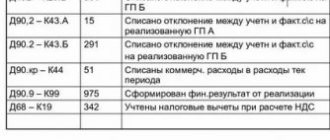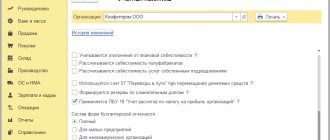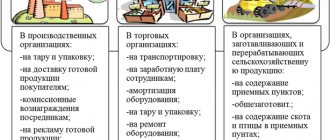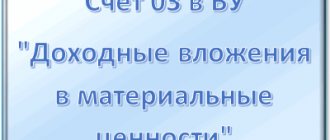To account for production costs, account 20 “Main production” is used. As a rule, an account in 1C 8.3 Accounting 3.0 is closed automatically. If this does not happen, consider 4 reasons for this situation and how to eliminate them.
Production costs can be direct, that is, those that relate to the production of products, and indirect, which cannot be linked to the production of certain products.
In the debit of account 20, where production costs fall, records are kept of material costs, depreciation of production equipment, labor costs and the accrual of contributions for it.
At the end of each month in the 1C 8.3 Accounting 20 program, the account is closed automatically to accounts 90, 43, 40.
To close the month you need:
- Correctly set up accounting policies for the production of products and the performance of production work and services;
- adjust the payroll of employees who participate in the production of products;
- correct maintenance of production documents - correctly indicate nomenclature groups and divisions;
- take into account the balance of work in progress.
Let's consider the necessary steps to close account 20 in the 1C 8.3 Accounting program.
Closing 20 accounts upon discontinuation of production
The reasons for the end of an organization's activities, changes in direction or assortment may be different.
Usually these are the consequences of long-term losses from the sale of illiquid products. If the stop was planned in advance, then the manufacturing cycle is completed and the question of where account 20 is closed does not cause problems - similar to operations carried out during normal operation. A sudden cessation of production leaves unfinished production - costs incurred on unfinished goods, acts not signed by the customer for the performance of work or the provision of services. In such a situation, the formulation is used that “the costs did not produce a positive result” and will not bring financial benefits in the future. An act on the write-off of work in progress is drawn up, indicating which account the 20th account is being closed into, the transactions through which will generate a loss for the organization. According to the Instructions for using the chart of accounts, register 91 “Other income and expenses” is used to reflect costs for economically negative projects.
To exclude claims from the tax inspectorate, it is advisable to prove that attempts were made to sell the available semi-finished products.
Introductory information
Very often, when working with 1C, we are faced with the problem of closing the 20th, 23rd, 25th and 26th accounts.
Judging by the number of relevant questions on the Online Accounting forum, the identified problem has not lost its relevance for a long time. I have read a lot on this topic, but sometimes I still fall into a stupor when I see an ownerless remnant that should not exist. In order to somehow systematize the information on this issue, I decided to summarize everything that I had read and studied “at random” in the program itself. Submit tax reports for free directly from 1C
How to close account 20 - postings
Before writing off the amounts accumulated on the register, it is necessary to distribute and reset the associated costs:
- Auxiliary production (account 23);
- General production expenses (account 25);
- Defects in production (account 28).
If an organization produces one type of product, then, prior to the closure of the 20th account, the collected costs are fully allocated to work in progress. If products are produced in an assortment or several types of work are performed, then costs are included in the cost proportionally according to the accepted method:
- Regarding revenue;
- Comparison of planned prices;
- Simultaneously according to two indicators.
Example
The company built a garage and hangar for customers in January. Planned prices are 50,000 and 100,000 rubles. respectively. General production expenses (salaries, depreciation, transport, etc.) amounted to 30,000 rubles, materials - 25,000 and 70,000, respectively.
How to close account 20 - postings:
| Debit | Credit | Sum | Operation |
| 10 000 | Costs related to garage | ||
| 20 000 | Hangar related costs | ||
| 5 000 | Damaged metal when welding a garage door | ||
| 25 000 | Materials written off within a month | ||
| 70 000 |
After calculating the full cost of the objects, the accountant will close account 20, the postings of which are based on the implementation method:
| Debit | Credit | Sum |
| 40 000 | The cost of the garage is reflected | |
| 90 000 | The cost of the hangar is reflected |
With the direct and intermediate methods, registers are adjusted from which the cost of objects at the time of sale was previously written off at planned prices. An example of how to close account 20 – correction postings:
| Debit | Credit | Sum | Operation |
| Direct option | |||
| Reversal – 10,000 | Garage | ||
| -10 000 | Hangar | ||
| -20 000 | Corrected the cost of work performed | ||
| Intermediate option | |||
| 150 000 | Planned cost of objects | ||
| 130 000 | Actual amount | ||
| -20 000 | Implementation adjustments | ||
With automatic accounting, the necessary account assignments are made by the program. You need to know how to close account 20 and make manual entries to resolve unforeseen situations.
Regular operations written by programmers are based on standard accounting rules and software features. Before ending the month, you need to make sure that the settings are correct, otherwise the 20th account will not be closed. If you don’t have time to find out and eliminate the causes, you can use an alternative option - independently carry out regulations upon completion of the production process.
Postings for closing account 20 are manually organized through the “Operations” menu. But it is advisable to set up the program for automatic processing, since in the future errors may occur when re-posting documents. The accounting algorithm uses cost accumulation registers, rather than numbers from costing accounts.
Accounting account 20 is the active calculation account “Main production”. Using simple examples for dummies, let's look at typical transactions for account 20 in accounting, as well as what transactions are used to close account 20.
Account 20 in accounting
Manufacturing enterprises use account 20 to record production costs, namely the costs of creating new products (services, works). In addition to costs, account 20 also reflects the material value of work in progress:
Determination of production costs
Production costs include direct costs attributable to the production of specific products, services provided or work of the main activity.
The following types of direct costs can be distinguished:
- Expenses for the purchase of raw materials for production and materials for the provision of works and services;
- Remuneration of production workers;
- Depreciation and repair of production fixed assets;
- Losses from marriage;
- Modernization, introduction of new technologies;
- Other costs of the production process.
Important! At the end of the reporting period or where there is no more detailed division (for example, auxiliary production and others), account 20 also displays:
- Expenses of auxiliary and service production;
- Indirect costs for the management and maintenance of main production.
Definition of work in progress (WIP)
Work in progress includes:
- Material assets that are in production or processing, as well as accepted for production, but not yet participating in the production process;
- Unshipped released products to storage warehouses.
To determine the amounts of work in progress, first describe all of the above material assets at the end of the reporting period, and then establish their valuation.
Account 20 Main production
Main properties of account 20 “Main production”:
- Only the valuation is taken into account;
- It is active and does not have a negative balance at the end of the period, but may have a positive balance, which is a cost indicator of work in progress;
- In addition to synthetic accounting, analytical accounting is also carried out in the context of types of products, costs (estimates) and by divisions of the organization.
Primary documents for accounting of production costs:
Errors when recording costs on direct expense accounts
There are two groups of errors here. First, problems with account 20 may arise if the allocated expenses are recorded in direct expense accounts. Expenses related to all types of activities are reflected under cost items with the type For different types of activities in the indirect cost accounts. We are talking about general business expenses (accounts 26) and general production expenses (25). Secondly, errors may be due to the fact that standardized expenses are recorded in direct expense accounts.
Standardized expenses are reflected by cost items as follows:
- voluntary personal insurance, which provides for payment of medical expenses by insurers;
- voluntary personal insurance in case of death or disability;
- voluntary insurance under long-term life insurance contracts, pension insurance and (or) non-state pension provision for employees;
- entertainment expenses;
- advertising expenses (standardized).
The calculation of the amount of recognition of these expenses for tax accounting is carried out in accordance with the norms established by law on an accrual basis from the beginning of the year only for indirect expenses of tax accounting.
Correspondence 20 accounts in accounting
Account 20 “Main production” corresponds with the following accounts:
Table 1. By debit of account 20:
| Dt | CT | Wiring Description |
| 20 | 02 | Accrual of depreciation of fixed assets |
| 20 | 04 | Introduction of new technologies into production |
| 20 | 05 | Calculation of depreciation of intangible assets |
| 20 | 10 | Write-off of materials, inventory, workwear and other things for production |
| 20 | 16 | Variance in the cost of materials written off for production |
| 20 | 19 | Non-refundable VAT on works (services) is included in costs |
| 20 | 21 | Write-off of semi-finished products for production purposes |
| 20 | 23 | Auxiliary production costs written off |
| 20 | 25 | General production costs taken into account |
| 20 | 26 | General business expenses taken into account |
| 20 | 28 | defects are included in production costs |
| 20 | 40, 43 | Manufactured products are written off for production needs or returned for revision |
| 20 | 41 | Goods written off for production needs |
| 20 | 60 | The work of third parties is taken into account in production costs |
| 20 | 68 | Amounts of taxes and fees written off for production needs |
| 20 | 69 | Insurance premiums for production workers have been calculated |
| 20 | 70 | Wages of production workers accrued |
| 20 | 71 | Accountable amounts were paid for production needs |
| 20 | 73 | Compensation to an employee for production costs (for example, a personal car, telephone calls) |
| 20 | 75 | The founders contributed the costs of the main production to the authorized capital |
| 20 | 76.2 | Claims against contractors and downtime |
| 20 | 79 | Production costs associated with the organization's divisions on a separate balance sheet |
| 20 | 80 | Acceptance of work in progress for accounting as a contribution to the authorized capital |
| 20 | 86 | Acceptance of work in progress for accounting as targeted financing |
| 20 | 91.1 | Excess work in progress was capitalized |
| 20 | 94 | Shortages and losses within the norms in the production process, without blame |
| 20 | 96 | The amount of reserves in production costs is taken into account |
| 20 | 97 | Write-off of a share of future expenses for production expenses |
Table 2. For account credit 20:
| Dt | CT | Wiring Description |
| 10 | 20 | Returnable materials or own material assets (for example, containers) have been capitalized |
| 15 | 20 | Write-off of works, services of main production |
| 21 | 20 | Semi-finished products are capitalized |
| 28 | 20 | Costs written off to correct defects |
| 40 (43) | 20 | The actual cost of manufactured products is written off (produced products are capitalized) |
| 45 | 20 | Transfer of products (works, services) to third parties |
| 76.01 | 20 | Insurance compensation costs written off |
| 76.02 | 20 | Reduced costs for the amount of claims made to contractors and downtime |
| 79 | 20 | Costs written off due to targeted financing of main production |
| 90.02 | 20 | The cost of services sold is written off |
| 91.02 | 20 | Costs in connection with the disposal of other assets of the organization (fixed assets, materials, etc.) or loss of work in progress due to emergencies are included in other expenses |
| 94 | 20 | Shortages in main production reflected |
| 99 | 20 | uncompensated losses due to extraordinary circumstances are included in losses |
Closing 20 accounts
Important! The method of closing account 20 should be specified in the accounting policy, and it should also indicate the distribution base, if necessary.
There are 3 options for closing an account:
- Direct method;;
- Intermediate method
- Direct sales of manufactured products.
Important! Before closing account 20, it is necessary to allocate the balances of work in progress.
Direct method
During the reporting period, the actual price is not known, and manufactured products are accounted for at conditional prices, for example, at planned cost.
When closing the month, the cost of manufactured products is adjusted to the actual cost.
Closing account 20 directly - postings:
| Dt | CT | Wiring Description |
| At the end of the month | ||
| 43 | 20 | Adjustment of released products |
| 90.02 | 43 | The deviation of the actual from the planned cost of products sold is written off to the cost of sales |
Important! When using this method, it is impossible to account for manufactured products at actual cost during the month.
Intermediate method
This method uses additional account 40 “Product Output”, which records deviations of the planned cost from the actual cost. For credit - planned cost, for debit - actual cost.
At the end of the month, the total amount of deviations is written off proportionally to account 43 “Finished products” and 90.02 “Cost of sales”.
Closing account 20 in an intermediate way - manual postings:
| Dt | CT | Wiring Description |
| 43 | 40 | Finished products were capitalized at planned cost |
| 90.02 | 43 | Sold products written off at planned cost |
| At the end of the month | ||
| 40 | 20 | The actual cost of manufactured products is written off |
| 43 | 40 | Adjusting entries that bring the planned cost to the actual cost |
| 90.02 | 40 | |
Direct sales of manufactured products
In this option, manufactured products are not stored, but are sold immediately from production. In this case, production costs are written off to cost of sales. Services are closed in this way.
Closing account 20 when selling services - manual postings:
| Dt | CT | Wiring Description |
| At the end of the month | ||
| 90.02 | 20 | Actual cost written off to cost of sales |
The distribution base for indirect costs has not been set
Problems with closing production cost accounts may arise due to the lack of an allocation base for indirect costs.
In this case, the balance will be incorrectly listed on account 25 or account 26. The distribution base for indirect expenses is set in the information register Methods for distribution of indirect expenses (menu Enterprise → Accounting policies → Methods for distribution of indirect expenses of organizations).
In this register, the rules must be set so that:
- all turnovers in the debit of accounts 25 and 26 were covered;
- all distribution bases were not equal to zero.
To see how the distribution base Planned cost of production is formed, you need to look at the records of the accumulation register Product output at planned prices (accounting) for the current period.
Examples of using account 20 in accounting
Let's look at the procedure for using account 20 “Main production”, as well as its closure using examples.
Example 1. Direct closing method
The Trigolki enterprise produces evening dresses. The accounting policy stipulates that product output is accounted for on account 43 “Finished products”, without taking into account account 40 “Product output”. During the month, 20 pieces of products were produced and 10 of them were sold at a price of 5,000.00 rubles. The planned cost was RUB 3,000.00. per piece
The amount of production costs is 70,000.00 rubles. of them:
- Material costs – RUB 55,000.00;
- The amount of depreciation is RUB 1,980.00;
- Remuneration and contributions – RUB 13,020.00.
Postings to account 20 in the form of a table according to the example:
| date | Account Dt | Kt account | Amount, rub. | Wiring Description | A document base |
| Production costs | |||||
| 10.10.2016 | 20 | 10 | 55 000,00 | Raw materials written off for production process | Requirement invoice |
| Output | |||||
| 16.10.2016 | 43 | 20 | 60 000,00 | Production of evening dresses (at planned cost) | Production report, receipt order (when moving to a warehouse) |
| Sales of finished products | |||||
| 20.10.2016 | 62 | 90.01 | 59 900,00 | Sales proceeds | TORG-12 |
| 20.10.2016 | 90.03 | 68 | 9 900,00 | VAT charged | |
| 20.10.2016 | 90.02 | 43 | 30 000,00 | Write-off of planned cost of goods sold | |
| Payroll for production workers | |||||
| 31.10.2016 | 20 | 70 | 10 000,00 | Salary accrued | Time sheet, payslip |
| 31.10.2016 | 70 | 68 | 1 300,00 | Personal income tax withheld | |
| 31.10.2016 | 20 | 69 | 3 020,00 | Insurance premiums accrued | |
| Closing the month | |||||
| 31.10.2016 | 20 | 02 | 1 473,41 | Depreciation of production machines has been calculated | |
| 31.10.2016 | 43 | 20 | 10 000,00 | Adjustment of production output | |
| 31.10.2016 | 90.02 | 43 | 5 000,00 | Adjustment of cost of goods sold | |
Example 2. Intermediate closing method
The Trigolki enterprise produces evening dresses. The accounting policy stipulates the use of account 40 “Product Output”. During the month, 10 pieces of products were produced and 7 of them were sold at a price of 4,500.00 rubles, VAT in total. The planned cost was RUB 2,700.00. per piece
The amount of production costs is 30,393.41 rubles. of them:
- Material expenses - 15,900.00 rubles;
- The amount of depreciation is RUB 1,473.41;
- Remuneration and contributions – RUB 13,020.00.
Solution to the example with transactions in the form of a table:
| date | Account Dt | Kt account | Amount, rub. | Wiring Description | A document base |
| Production costs | |||||
| 10.10.2016 | 20 | 10 | 15 900,00 | Raw materials written off for production process | Requirement invoice |
| Output | |||||
| 16.10.2016 | 43 | 40 | 27 000,00 | Production of evening dresses (at planned cost) | Production report, receipt order (when moving to a warehouse) |
| Sales of finished products | |||||
| 20.10.2016 | 62 | 90.01 | 31 500,00 | Sales proceeds | TORG-12 |
| 20.10.2016 | 90.03 | 68 | 4 805,08 | VAT charged | |
| 20.10.2016 | 90.02 | 43 | 18 900,00 | Write-off of planned cost of goods sold | |
| Payroll for production workers | |||||
| 31.10.2016 | 20 | 70 | 10 000,00 | Salary accrued | Time sheet, payslip |
| 31.10.2016 | 70 | 68 | 1 300,00 | Personal income tax withheld | |
| 31.10.2016 | 20 | 69 | 3 020,00 | Insurance premiums accrued | |
| Closing the month | |||||
| 31.10.2016 | 20 | 02 | 1 473,41 | Depreciation of production machines has been calculated | |
| 31.10.2016 | 40 | 20 | 30 393,41 | Adjustment of production output | |
| 31.10.2016 | 43 | 40 | 3 393,41 | Adjustment of planned cost to actual cost | |
| 31.10.2016 | 90.02 | 43 | 2 375,39 | Adjustment of cost of goods sold | |
Example 3. Direct sale of released products (production of services)
The RemontTorg enterprise provides repair services. October 20, 2016 repair work was provided in the amount of 20,000.00 rubles, the planned cost of which was 15,000.00 rubles.
Production costs amounted to RUB 17,000.00. of them:
- Material costs – RUB 2,000.00;
- The amount of depreciation is RUB 1,980.00;
- Remuneration and contributions – RUB 13,020.00.
Closing account 20 manually when providing services:
| date | Account Dt | Kt account | Amount, rub. | Wiring Description | A document base |
| Production costs | |||||
| 10.10.2016 | 20 | 10 | 2 000,00 | Spare parts and raw materials written off for the production process | Requirement invoice |
| Providing repair work | |||||
| 20.10.2016 | 62 | 90.01 | 23 600,00 | Sales proceeds | TORG-12 |
| 20.10.2016 | 90.03 | 68 | 3 600,00 | VAT charged | |
| 20.10.2016 | 90.02 | 20 | 15 000,00 | Write-off of planned cost of goods sold | |
| Payroll for production workers | |||||
| 31.10.2016 | 20 | 70 | 10 000,00 | Salary accrued | Time sheet, payslip |
| 31.10.2016 | 70 | 68 | 1 300,00 | Personal income tax withheld | |
| 31.10.2016 | 20 | 69 | 3 020,00 | Insurance premiums accrued | |
| Closing the month | |||||
| 31.10.2016 | 90.02 | 20 | 2 000,00 | Adjustment of the cost of work performed | |
>How to work with account 20 of the chart of accounts
Main production: determining the composition of costs
The production process is a technological cycle for the creation, development, and assembly of finished products at an enterprise. The totality of all costs associated with the production and sale of finished products forms its cost.
The main production can be described as follows. Organizations carrying out production activities determine the cost of manufactured products. To account for the total amounts of such expenses, account 20 is used, the transactions for which we have collected in one table. It is applied in accordance with the chart of accounts approved by Order of the Ministry of Finance of the Russian Federation No. 94n dated October 31, 2000.
Primary production costs are costs that relate to the production of certain types of goods, works or services directly related to the main activity of the enterprise. Such costs can be direct or indirect.
Direct costs include the costs of purchasing raw materials and supplies involved in the manufacture of goods in a broad sense, remuneration for workers, damage from defects, depreciation, etc.
Indirect costs include costs associated with maintenance, administration and control of the production process.
It turns out that accounting account 20 for dummies is “Main production”, which reflects all production and general business costs of the organization.
At the “Main production” the following costs are taken into account:
- production of industrial and agricultural products;
- carrying out construction, installation, dismantling, geological exploration and design and survey work;
- provision of communication and transportation services;
- carrying out R&D work - research and development work;
- maintenance, operation and repair of highways, etc.
Basic cost structure
Account 20 accumulates the following types of costs:
- material, which are aimed at purchasing materials, raw materials, supplies, equipment, etc., necessary in the production process;
- wages and social needs - costs that go towards wages and insurance premiums for workers and other persons involved in production;
- depreciation - deduction for wear and tear of fixed assets that are directly involved in the manufacturing process;
- other costs, which include travel expenses, shortages identified within the limits of natural loss, deferred costs, etc.
In order for an accountant to be able to include indirect costs in the cost of each unit of goods manufactured, work performed or service rendered, these costs must be distributed. An enterprise has the right to independently choose one indicator of cost distribution, for example, the value of inventory assets used in the process of manufacturing goods.
Costs recorded in accounting account 20 should be written off to the standard (planned) or actual cost of manufactured products.
Subaccounts and analytics
The main production - count 20 - is active. Synthetic and analytical accounting is carried out on it. Sub-accounts are opened depending on the specifics of the activity and industry of the organization. Analytical accounting is carried out by type of costs of products that the enterprise produces, or by structural divisions of the enterprise.
The credit of account 20 reflects the write-off of the full cost of finished products, the debit serves to take into account the total amount of all costs for the production of industrial products.
Accounting on account 20 “Main production” can also be carried out using subaccounts:
- 20.1 - crop production. It is intended to reflect costs and output of crop products, including accounting for horticultural products and growing seedlings.
- 20.2 - livestock farming. Data on costs and output of livestock products are reflected here. Analytics of livestock products is carried out by types and groups of animals and poultry, as well as by established types of costs.
- 20.3 - industrial production. This takes into account accounting information about the production and release of the results of the main production, preparation and development of production, etc. The actual cost is carried out under credit 20.3, and the balance at the end of the period for this sub-account (in accordance with analytical accounting data) indicates the cost indicator for work in progress industrial production.
- 20.4 - other main production and activities. Designed to accumulate accounting data for certain types of activities and for agricultural chemical organizations, machine-technological stations, and off-farm enterprises. This subaccount includes expenses for harvesting, transporting fertilizers, working with soils, protecting plants, improving land, operating costs for vehicles of MTS organizations and agricultural chemicals, etc. Accounting for the costs of maintaining cars, trucks and other special vehicles is carried out for each type separately.
Cost analytics not completed
To correctly close twentieth accounts, it is important to indicate all objects of analytical cost accounting when reflecting expenses and output. To check, you should generate the report Turnover balance sheet for accounts 20, 23, 25, 26 in detail for all types of subaccounts.
In relation to turnover on the debit of accounts 20, 23, the following must be indicated: Division, Nomenclature group, Cost item. For turnover on the credit of accounts 20, 23, the following must be indicated: Division, Nomenclature group. For turnover on the debit of accounts 25, 26, the following must be indicated: Division, Cost Item.
Closing an account
Closing is carried out at the end of the reporting month or upon the end of the production period or cycle. Often the 20 account has no balance, that is, it is reset to zero. If a debit balance has formed for “Main Production”, then it will reflect the value of work in progress as of a specific date. This balance is carried forward to the beginning of the next reporting period. Closing account 20 can be carried out for certain types of goods, works or services produced, and for other analytical registers the balance will be reflected in the form of work in progress.
Closing can be done in one of the following ways:
- straight;
- intermediate;
- direct sales of released products.
The closing methodology and cost allocation basis are prescribed in the accounting policy and cannot be changed or canceled during the reporting period.
Here is a brief instruction on how to close a 20 account using the direct method. During the reporting period or production cycle, there is no accurate information about the price of the product. Production results are reflected at deemed cost. You can take into account prices at planned cost, but accounting at actual cost during the reporting period is not allowed. After its completion, the accountant will already know the amount of the actual cost, after which the appropriate adjustment will be made to close the 20th account.
Postings at closing
The accounting entries in this case will be as follows:
- Dt 43 Kt 20 - adjustment to the actual cost;
- Dt 90.02 Kt 43 - reflection of deviation.
For the intermediate method, account 40 “Product Output” is used. It reflects data on the deviation of the planned value from the actual value. The debit reflects the fact, and the credit shows the plan.
Closing of account 20 is carried out after writing off the resulting deviation according to the following transactions:
- Dt 40 Kt 20 - write-off of actual cost;
- Dt 43, 90.2 Kt 40 - bringing the planned indicator to the actual one.
When directly selling released goods, works or services, all products are immediately sold, and costs are written off directly to cost, after which account 20 is closed using posting Dt 90.02 Kt 20.
Account 20 is closed depending on the chosen cost distribution method:
- the balance can only be due to work in progress;
- the direct method writes off 43, 90 accounts;
- the indirect method runs through intermediary accounts 40, 43;
- the direct implementation method debits to account 90;
- in 1C versions 8.2 and 8.3 the account is closed automatically.
In accounting, closing a month is a whole cycle of operations that must be carried out to correctly form the company’s balance sheet.
The order of divisions is not established
If the operations of closing cost accounts are determined manually (Accounting policy, tab Release of products, services), then this sequence must be specified. To do this, you need to create a document “Setting the order of departments for closing cost accounts.” If such a document has already been created, it may contain irrelevant data. In order to correct this error, you need to create a new document with the current date, automatically filling out the document using the “fill” button
Main characteristics
There are accounts that must be closed at the end of the period, since they reflect the results of business activities that form profits and losses. These include account 20 “Main production”.
The name of the account speaks for itself - it reflects the main activities of the enterprise, that is, direct costs for the formation of the cost of products (works, services).
From the author! It doesn’t matter whether the company is producing products or providing services, the main condition for using the 20th account is the presence of a core activity.
The costs of producing products (works, services) are accumulated in the debit of the account. In addition to expenses, there is the material value of work in progress.
When the work is completed, the loan account is closed. However, this may be the detection of a manufacturing defect. In such cases, 20 must be closed for the amount of unusable goods:
- Dt 28 “Defects in production” Kt 20 “Main production”.
Direct expenses that are usually attributed to account 20:
- Purchase of raw materials and materials involved in the production process.
- Remuneration and contributions to the budget of production workers.
- Repair and depreciation of production equipment.
- Expenses for modernization and innovation.
- Other costs.
20 is essentially active. Closing account 20 using manual operations is a long and labor-intensive process, since analytical accounting is deployed on it:
- according to the nomenclature that contains types of activities;
- by department;
- by cost items;
- on the work of production programs (if there are investment projects).
Three Cost Allocation Methods
Three methods have been adopted for allocating costs for main production:
- Straight.
- Indirect (intermediate).
- Direct sales of manufactured products.
Ease of direct sales of manufactured products
The simplest of them is direct implementation. It is suitable for companies that provide services. Since the issue of trade, defects and work in progress does not arise, you can apply the accounting certificate in 1C, regardless of the configuration.
It is necessary to create a balance sheet for account 20 in order to see the final balance at closing. Go to the “Accounting, Taxes, Reporting” menu, “Accounting” submenu. Find the section “Operations entered manually” or “Operations log” and click the “Create” button. You need to enter the following wiring into the operation:
- Dt 90.02 “Cost of sales” Kt 20 - enter the debit balance from the balance sheet.
From the author! With this method, detailed analytics are not carried out. All costs add up to 2-3 standard types, otherwise transactions to close account 20 will take a lot of time.
For example, for Creator LLC, renting its own non-residential premises is the main activity. The cost of rent consists of a variety of direct and indirect costs. Account 20 collected expenses in the amount of 6,000,000 rubles:
- utility costs for the maintenance of rented premises;
- repair and emergency work;
- salaries of employees serving tenants;
- taxes and fees on employee salaries;
- rental of land plots on which buildings stand.
Table 1. Analysis of account 20 for August 2021 Limited Liability Company "Creator"
| Cor. Check | Debit | Credit | ||
| Opening balance | ||||
| 740.953,52 | ||||
| 633.633,68 | ||||
| 1.589.272,19 | ||||
| 602.185,03 | ||||
| 1.200.496,72 | ||||
| 264.734,74 | ||||
| 882.449,12 | ||||
| 19500,00 | ||||
| 66.775,00 | ||||
| 6.000.000,00 | ||||
| Turnover | 6.000.000,00 | 6.000.000,00 | ||
| Closing balance | ||||
Output data: BU (accounting data)
Once a month, the accounting department issues acts to tenants using the document “Sales of services” in 1C, which generates the following transactions:
- Dt 62.01 “Settlements with buyers and customers” Kt 90.01 “Revenue” - for the rental amount of 9,400,000 rubles;
- Dt 90.03 “Value Added Tax” Kt 68.02 “Value Added Tax” - 18% VAT in the amount of RUB 1,433,898.31 is allocated. to be paid to the budget.
When closing a period, the method of direct sales of released products is used:
- Dt 90.02 Kt 20 - the actual cost of 6,000,000 rubles is closed.
Therefore, net revenue will be:
- 9,400,000 - 1,433,898.31 - 6,000,000 = 1,966,101.69 rubles.
When the actual cost is unknown
The direct method is used in manufacturing enterprises if the actual cost of finished products is unknown. Therefore, the company takes into account costs at the planned cost, and at the end of the month makes an adjustment, bringing the price of manufactured products to the actual price. Wiring used:
- Dt 43 “Finished products” Kt 20 - for the amount of adjustment;
- Dt 90.02 Kt 43 - deviations of the actual cost from the planned cost are written off.
Using an intermediate method
The indirect method involves the participation of 40 “Release of products (works, services)”. It simultaneously takes into account the planned (credit) and actual (debit) cost. Balance at 40 is the resulting deviations. The accounting department needs to close interim accounts at the end of the month:
- Dt 43 Kt 40 - finished products are received at the planned price;
- Dt 90.02 Kt 43 - products sold are written off at planned cost;
- Dt 40 Kt 20 - the cost of production is written off in fact;
- Dt 43 Kt 40 - adjustment between two costs;
- Dt 90.02 Kt 40 - all adjustments are written off.
From the author! Using the interim cost allocation method involves manually closing the month.
Cost analytics is not filled out or filled in incorrectly
To correctly close cost accounts, it is very important to correctly indicate all objects of analytical cost accounting when reflecting expenses and output. To check, you need to generate a report: Turnover balance sheet for account 20, 23, 25, 26 with details for all types of subaccounts.
In the debit turnover of accounts 20, 23, the following details are required to be filled in: Division, Nomenclature group, Cost item. For turnover on the credit of accounts 20, 23 - Division, Nomenclature group. For turnovers on the debit of accounts 25, 26 - Division, Cost Item.
Operations in software products
When performing automatic regulatory operations in 1C, you should remember that all analytics must be registered when creating primary documents. Otherwise, it will not be possible to carry out the routine operation, since all unfilled subcontos will result in numerous errors:
- production of products, provision of services or balances of work in progress are not reflected;
- the order of divisions is not established;
- cost analytics is not completed;
- the counter issue accounting register is not filled in;
- the distribution base for indirect costs has not been specified.
If an error occurs, you need to go through the documents and fill in the missing analytics. To make it easier to understand, you can watch the video:
To create an operation in 1C 8 versions 2.0 and 3.0, you need to go to the “Accounting, Taxes and Reporting” menu, the “Period Closing” section, the “Month Closing” submenu or “Routine Operations”. But before you create the operation “Closing accounts 20, 23, 25, 26”, you must complete the previous operations.
You need to perform “Re-posting documents for the month”, then reflect wages, reserves, depreciation, etc.
Figure 1. Monthly closing sequence
The direct implementation method is suitable for automatic closing in 1C Enterprise 8.2 and 8.3. In order for the program to close more complex methods, you will have to make the appropriate settings.
For tax accounting purposes, all direct expenses are included in the formation of the income tax base. In order for the tax to be calculated correctly, you need to configure the directory in 1C “Direct Expenses”. If any costs are not included in the list, the program will automatically display them in 90.08 “Administrative expenses”.
1C UPP contains a mechanism for distributing costs, carried out using production documents or special processing “Calculation of cost”. With the direct distribution method, this will be “Production report for the shift”, “Distribution of materials for production”. With the indirect method - “Calculation of cost”.
In 1C version 7.7 there is also a “Month Closing” menu. In order for the automatic completion of the period on the 20th account to occur here, you need to check the box in the line “Calculation and adjustment of the cost of GP and PF”. Documents used by the accounting department when maintaining the production cycle:
- Transfer of materials to production.
- Transfer of materials into operation.
- Transfer of finished products to the warehouse.
The accounting algorithm affects the possibility of conducting manual or routine operations, since the slightest violation of the order will not allow the account to be closed correctly.
Displaying both types of expenses in accounting
The table “Settings for reflecting and writing off expenses in accounting” (below) contains settings for both types of expenses in accounting, which are located in the “Main/Accounting policies” section.
Figure 3. Accounting policy settings
Table. “Settings for reflecting and writing off costs in accounting”
Commercial structures whose business is based on services to manufacturers check the box next to “Performing work/providing services...” to set up “Costs are written off” according to one of the options:
- “Excluding revenue”: from Kt 20 to Dt 90.02, i.e. even if there is no turnover on account 90.01.
- “Taking into account all revenue”: from Kt 20 to Dt account 90.02 in the context of item groupings for which it was.
- “Taking into account revenue only from production services”: can be written off after registration of the issue through an act of services rendered.
Figure 4. “Performance of work, provision of services to customers” and the “Costs are written off” setting
Manufacturers themselves must mark the execution as “Product release”.
Figure 5. “Product output”
After these steps, a set of switches “General expenses are included” will become available:
Figure 8. Raman diversity methods
Figure 9 Methods for distributing general production and general expenses
Figure 10 Setting up the CD diversity rule
Thus, indirect expenses from Kt 26 will be written off to Dt of direct accounts - 20 or 23 (in the second case, at the end of the month, additional expenses will be automatically written off to Dt 20, and then from Kt 20 to 40 or 43).
Figure 11 Postings for writing off PR to the cost of production
If account 25 is used to display indirect expenses in a manufacturing company, then you need to establish a rule for posting them on direct accounts using the link to the posting methods discussed above. According to the accounting methodology, from 25 they are posted to Dt 20 or 23. Similarly, in the case of distribution to 23, at the end of the month the costs will automatically be written off to Dt 20, and then closed at 40 or 43.
Figure 12 General scheme for closing Account 20/23/25/26 for a production organization
That is, when closing the month, indirect expenses are first written off from Kt 26 to Dt 90.08 (in case of write-off using the direct costing method) or from Kt 26 to Dt 20 or 23 (according to the posting rules, if any have been established). Costs from 25 will be written off in Dt 20 or 23 according to the redistribution rules. Direct items are written off by item groups to cost.
Free expert consultation
Natalia Sevorina
Consultant-analyst 1C
Thank you for your request!
A 1C specialist will contact you within 15 minutes.









